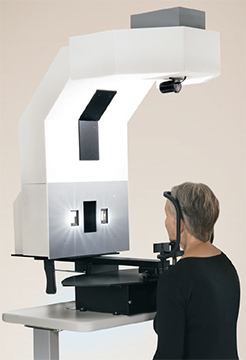OLÉ: Facial Imaging System with Overhead Lighting Environment
 Canfield’s novel imaging system, with an open-air Overhead Lighting Environment (OLE) facilitates clinical assessment of facial skin aging attributes by simulating how the subject is perceived by the human eye in everyday settings. Historically, facial skin imaging has been accomplished using closed imaging environments for illuminating the subject with uniform diffused lighting, while eliminating unwanted effects of ambient light. While a closed environment is also ideal for fluorescence and absorption imaging, direct illumination and secondary reflections may reduce contrast of skin topographical features. Natural lighting, under which a subject’s face is typically perceived, is overhead and directional. Directional / raked lighting reveals surface textures by illuminating features facing the light, while creating shadows for those facing away.
Canfield’s novel imaging system, with an open-air Overhead Lighting Environment (OLE) facilitates clinical assessment of facial skin aging attributes by simulating how the subject is perceived by the human eye in everyday settings. Historically, facial skin imaging has been accomplished using closed imaging environments for illuminating the subject with uniform diffused lighting, while eliminating unwanted effects of ambient light. While a closed environment is also ideal for fluorescence and absorption imaging, direct illumination and secondary reflections may reduce contrast of skin topographical features. Natural lighting, under which a subject’s face is typically perceived, is overhead and directional. Directional / raked lighting reveals surface textures by illuminating features facing the light, while creating shadows for those facing away.
Recent News in White Paper/Editorials
- Quantitative Analysis of Facial Features
- Prevention of Melasma Relapses With Sunscreen Combining Protection Against UV and Short Wavelengths of Visible Light: A Prospective Randomized Comparative Trial
- Comparative Analysis of Total Body and Dermatoscopic Photographic Monitoring of Nevi in Similar Patient Populations at Risk for Cutaneous Melanoma
- The significance of Shallow Thermal Effects from a laser on Collagenous Fibrous Septae and Reticular Dermis
Most Recent News
- "Improving Diversity in a Novel Psoriasis Study VISIBLE as a Framework for Clinical Trial Quality Improvement" Featured in JAMA Dermatology
- "Oral Minoxidil For Late Alopecia In Cancer Survivors" Featured In Breast Cancer Research and Treatment
- "A Prospective, Multi-Center Study to Evaluate the Safety and Efficacy of a Vegan Nutraceutical to Improve Hair Growth and Quality in Females Following a Plant-Based Diet" Featured in Journal of Drugs in Dermatology
- "Assessment of the Reproducibility and Accuracy of the VISIA® Complexion Analysis Camera System for Objective Skin Analysis of Facial Wrinkles and Skin Age" Featured in GMS Interdisciplinary Plastic and Reconstructive Surgery DGPW
